Data Science Tutorial for Beginners
2. Domain Expertise: In data science, domain expertise binds data science together. Domain expertise means specialized knowledge or skills of a particular area. In data science, there are various areas for which we need domain experts.
3. Data engineering: Data engineering is a part of data science, which involves acquiring, storing, retrieving, and transforming the data. Data engineering also includes metadata (data about data) to the data.
4. Visualization: Data visualization is meant by representing data in a visual context so that people can easily understand the significance of data. Data visualization makes it easy to access the huge amount of data in visuals.
5. Advanced computing: Heavy lifting of data science is advanced computing. Advanced computing involves designing, writing, debugging, and maintaining the source code of computer programs.
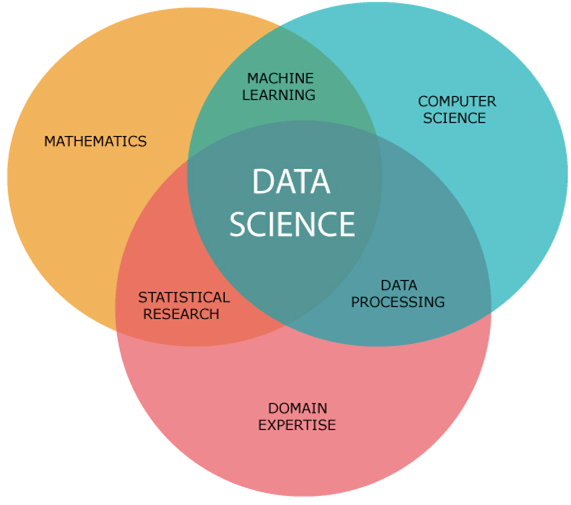
6. Mathematics: Mathematics is the critical part of data science. Mathematics involves the study of quantity, structure, space, and changes. For a data scientist, knowledge of good mathematics is essential.
7. Machine learning: Machine learning is backbone of data science. Machine learning is all about to provide training to a machine so that it can act as a human brain. In data science, we use various machine learning algorithms to solve the problems.
Tools for Data Science
Following are some tools required for data science:
- Data Analysis tools: R, Python, Statistics, SAS, Jupyter, R Studio, MATLAB, Excel, RapidMiner.
- Data Warehousing: ETL, SQL, Hadoop, Informatica/Talend, AWS Redshift
- Data Visualization tools: R, Jupyter, Tableau, Cognos.
- Machine learning tools: Spark, Mahout, Azure ML studio.
Machine learning in Data Science
To become a data scientist, one should also be aware of machine learning and its algorithms, as in data science, there are various machine learning algorithms which are broadly being used. Following are the name of some machine learning algorithms used in data science:
- Regression
- Decision tree
- Clustering
- Principal component analysis
- Support vector machines
- Naive Bayes
- Artificial neural network
- Apriori
We will provide you some brief introduction for few of the important algorithms here,
1. Linear Regression Algorithm: Linear regression is the most popular machine learning algorithm based on supervised learning. This algorithm work on regression, which is a method of modeling target values based on independent variables. It represents the form of the linear equation, which has a relationship between the set of inputs and predictive output. This algorithm is mostly used in forecasting and predictions. Since it shows the linear relationship between input and output variable, hence it is called linear regression.
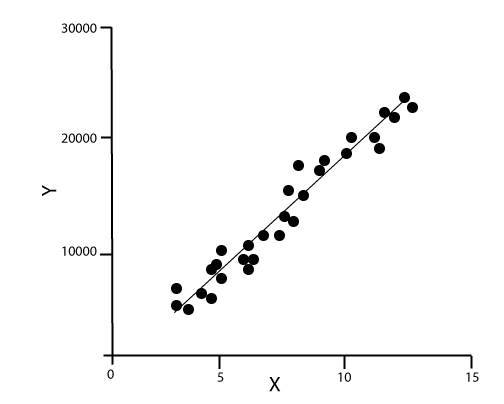
The below equation can describe the relationship between x and y variables:
- Y= mx+c
Where, y= Dependent variable
X= independent variable
M= slope
C= intercept.
2. Decision Tree: Decision Tree algorithm is another machine learning algorithm, which belongs to the supervised learning algorithm. This is one of the most popular machine learning algorithms. It can be used for both classification and regression problems.
In the decision tree algorithm, we can solve the problem, by using tree representation in which, each node represents a feature, each branch represents a decision, and each leaf represents the outcome.
Following is the example for a Job offer problem:
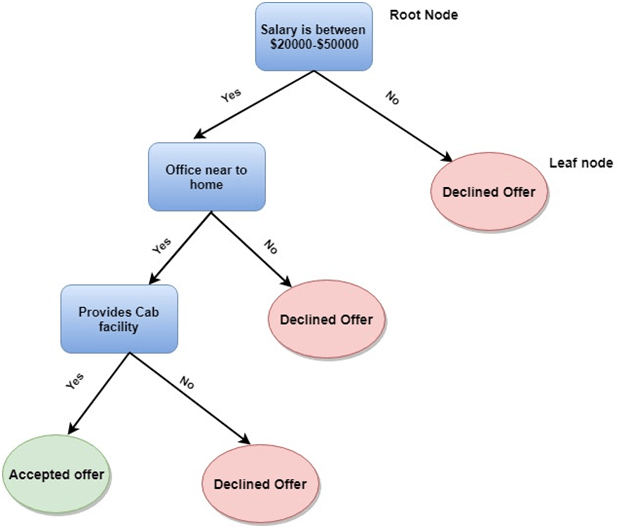
In the decision tree, we start from the root of the tree and compare the values of the root attribute with record attribute. On the basis of this comparison, we follow the branch as per the value and then move to the next node. We continue comparing these values until we reach the leaf node with predicated class value.
3. K-Means Clustering: K-means clustering is one of the most popular algorithms of machine learning, which belongs to the unsupervised learning algorithm. It solves the clustering problem.
If we are given a data set of items, with certain features and values, and we need to categorize those set of items into groups, so such type of problems can be solved using k-means clustering algorithm.
K-means clustering algorithm aims at minimizing an objective function, which known as squared error function, and it is given as:

Where, J(V) => Objective function
'||xi - vj||' => Euclidean distance between xi and vj.
ci' => Number of data points in ith cluster.
C => Number of clusters.
How to solve a problem in Data Science using Machine learning algorithms?
Now, let's understand what are the most common types of problems occurred in data science and what is the approach to solving the problems. So in data science, problems are solved using algorithms, and below is the diagram representation for applicable algorithms for possible questions:
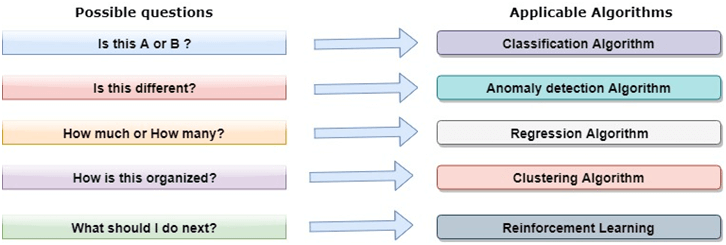
Is this A or B? :
We can refer to this type of problem which has only two fixed solutions such as Yes or No, 1 or 0, may or may not. And this type of problems can be solved using classification algorithms.
Is this different? :
We can refer to this type of question which belongs to various patterns, and we need to find odd from them. Such type of problems can be solved using Anomaly Detection Algorithms.
How much or how many?
The other type of problem occurs which ask for numerical values or figures such as what is the time today, what will be the temperature today, can be solved using regression algorithms.
How is this organized?
Now if you have a problem which needs to deal with the organization of data, then it can be solved using clustering algorithms.
Clustering algorithm organizes and groups the data based on features, colors, or other common characteristics.
Data Science Lifecycle
The life-cycle of data science is explained as below diagram.
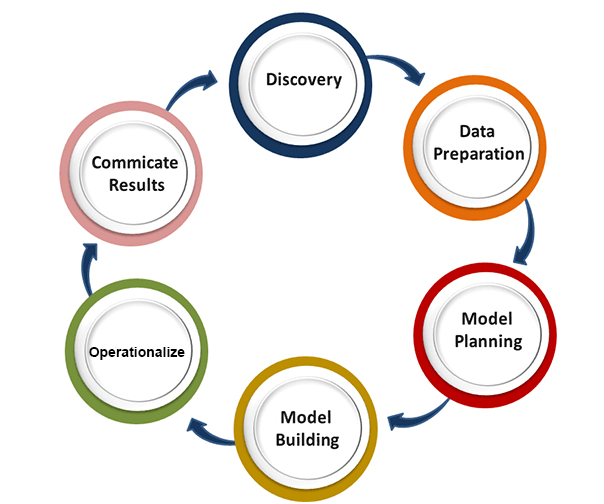
The main phases of data science life cycle are given below:
1. Discovery: The first phase is discovery, which involves asking the right questions. When you start any data science project, you need to determine what are the basic requirements, priorities, and project budget. In this phase, we need to determine all the requirements of the project such as the number of people, technology, time, data, an end goal, and then we can frame the business problem on first hypothesis level.
2. Data preparation: Data preparation is also known as Data Munging. In this phase, we need to perform the following tasks:
- Data cleaning
- Data Reduction
- Data integration
- Data transformation,
After performing all the above tasks, we can easily use this data for our further processes.
3. Model Planning: In this phase, we need to determine the various methods and techniques to establish the relation between input variables. We will apply Exploratory data analytics(EDA) by using various statistical formula and visualization tools to understand the relations between variable and to see what data can inform us. Common tools used for model planning are:
- SQL Analysis Services
- R
- SAS
- Python
4. Model-building: In this phase, the process of model building starts. We will create datasets for training and testing purpose. We will apply different techniques such as association, classification, and clustering, to build the model.
Following are some common Model building tools:
- SAS Enterprise Miner
- WEKA
- SPCS Modeler
- MATLAB
5. Operationalize: In this phase, we will deliver the final reports of the project, along with briefings, code, and technical documents. This phase provides you a clear overview of complete project performance and other components on a small scale before the full deployment.
6. Communicate results: In this phase, we will check if we reach the goal, which we have set on the initial phase. We will communicate the findings and final result with the business team.
Applications of Data Science:
- Image recognition and speech recognition:
Data science is currently using for Image and speech recognition. When you upload an image on Facebook and start getting the suggestion to tag to your friends. This automatic tagging suggestion uses image recognition algorithm, which is part of data science.
When you say something using, "Ok Google, Siri, Cortana", etc., and these devices respond as per voice control, so this is possible with speech recognition algorithm. - Gaming world:
In the gaming world, the use of Machine learning algorithms is increasing day by day. EA Sports, Sony, Nintendo, are widely using data science for enhancing user experience. - Internet search:
When we want to search for something on the internet, then we use different types of search engines such as Google, Yahoo, Bing, Ask, etc. All these search engines use the data science technology to make the search experience better, and you can get a search result with a fraction of seconds. - Transport:
Transport industries also using data science technology to create self-driving cars. With self-driving cars, it will be easy to reduce the number of road accidents. - Healthcare:
In the healthcare sector, data science is providing lots of benefits. Data science is being used for tumor detection, drug discovery, medical image analysis, virtual medical bots, etc. - Recommendation systems:
Most of the companies, such as Amazon, Netflix, Google Play, etc., are using data science technology for making a better user experience with personalized recommendations. Such as, when you search for something on Amazon, and you started getting suggestions for similar products, so this is because of data science technology. - Risk detection:
Finance industries always had an issue of fraud and risk of losses, but with the help of data science, this can be rescued.
Most of the finance companies are looking for the data scientist to avoid risk and any type of losses with an increase in customer satisfaction.




0 Comments